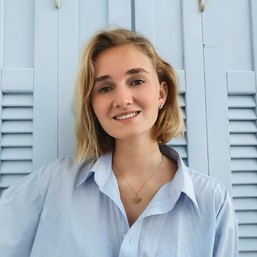
Opinion | Why do only white men speak about white men in art history?
Art history student Tessa Vallinga (22) is surprised by her course’s focus on a white curriculum. It is often white men who talk about other white men. “I would have liked to hear stories from artists further from the ‘Western’ realm, like Ben Enwonwu or Augusta Savage.”
Rembrandt, Van Gogh, Matisse, Magritte, and Miró. The heroes of art are predominantly male, white, and European, just like the people who wrote about them. Men who supported each other, did not criticize, and affirmed the same beliefs. Writers of the beautiful, but burdened with blind spots for the beautiful from beyond the borders of Europe.

The result? Exclusion. Those who play by their rules are allowed to participate and are seen and heard. Those who practice a different trade language are not admitted and the current players will not change the rules of the game. Clearly, the art history debate must break free of these blind spots and the Eurocentric thinking that places Western cultural norms and values over those of the rest of the world.
Yet the bachelor of art history still focuses fundamentally on Europe. Somehow I, an art history student, understand that. You don’t easily forget the stories of passionate professors. The ones about Carravaggio’s chiaroscuro technique or Bernini’s bronze doors. Ah yes, Italy...that’s insane, too. But so were the African sculptures from Benin. Sixteenth-century heritage, stolen by the British during a punitive expedition in 1897. Not only beautiful but important within this debate.
Except that faculty at the UvA hardly venture in the direction of art from Africa and other continents. Why not? What art history belongs to Asia, Africa, and the Americas, I wondered during my first year of study. The knowledge and information is obviously there. After all, Europe colonized these continents, which brought about cultural exchanges. It entailed predation and barter, but also mutual inspiration. Curious students who want to learn more can specialize, albeit through a scant number of electives on the global art world. For further exploration, they are referred to the Black Archives or other exhibition venues. There they are on their own, outside of UvA classes.
In the second year of study, this changes, at least somewhat. Four hours a week for eight weeks. That’s how much we sat in the lecture hall for the Art Worlds course, a required module of the undergraduate program dedicated to the question, “How can we write a global art history?” It was about the Benin sculptures and similar art, providing lessons on how we, future art historians, must not limit ourselves to traditional theories. That we had to be open to collaboration with experts from around the world to breathe life into terms like those used by art historian Wilfried van Dammes: “interculturality” and “interdisciplinarity,” as explained in his book World Art Studies: Exploring Concept and Approaches. An example of a “playful exploration” of a global art history, the lecturers called it.
Who did we learn that from?
To be exact, it was mostly male guest speakers. A woman here and there, but all with white skin. Theory on PowerPoint slides, read in the same language, played by the same rules. They read aloud perhaps the most important lessons from the entire course up to that point. Remarkably, not a single lecture hour was accorded to a guest speaker of another language or from another playing field.
A strange contradiction. Our professors said they recognized cultural exchange in art history debate because it is the engine of innovation. This is evidenced by the works of European artists like Max Ernst, which never would have existed without the influence of those different cultures. Yet, even the teachers found true recognition problematically difficult. There was only room for their own voices and their own research findings. All were blind to the guest lecture deficit, which, unintentionally perhaps, perpetuated the very system they were trying to break. Saying it is important to celebrate cultural exchange is quite different from actually sounding the trumpets.
Guest speakers surely made a splash with the lecture series. Fired by passion, born of expertise through research, like the lectures on Italian art. I would have loved to hear the stories and experience the same depth for artists further removed from the Western realm, like Nigerian painter and sculptor Ben Enwonwu and African-American sculptor Augusta Savage. Not just because that would have made them more fun, but because it would have brought the theory discussed in the lecture hall to life. It would have provided a real-life example for students that things can be done differently, rather than just delivering a statement that things should be different.
Where did this go wrong, my fellow students and I asked, since the person who usually coordinated the module did invite guest speakers in previous years. “He is on sabbatical this year,” was the excuse. Understandable, I thought, that a sabbatical is desirable when you carry the entire diversity of the bachelor of art history on your shoulders.
The message was bright white.
Tessa Vellinga is a second-year art history student.

